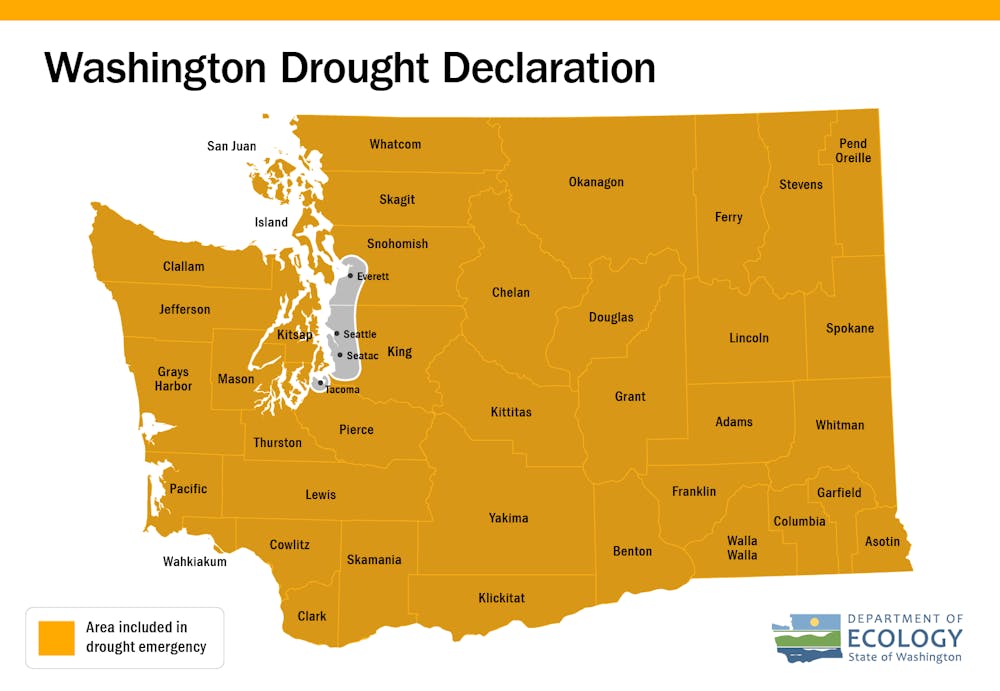Washington state has a reputation for being a rainy and wet environment. Despite this, the Washington State Department of Ecology issued an emergency drought declaration on April 16, 2024. Average rainfall is currently less than usual at this point in the year, but low rainfall alone is not enough to cause a drought. The real issue lies in the mountains.
With warmer-than-average temperatures through winter and early spring, more precipitation has fallen as rain than as snow.
“The temperatures for this year have been shown to play a bigger role in how poor our snowpack turned out to be,” Karin Bumbaco, interim state climatologist, said.
According to Bumbaco, the first thing people think about during a drought is a lack of rain. In Washington, droughts can happen for various reasons.
A drought declaration is considered when a region's water supply is less than 75% of normal. The current snowpack in Washington state is 63% of normal, according to the state Department of Ecology. Areas such as Lower Yakima are measuring at 40% of normal snowpack.
The snowpack plays a vital role in water supply for the spring and summer seasons. In a typical season, the snowpack would gradually melt and serve as a water source through the drier seasons. Having less snow may mean less water, causing hardship in certain areas.
“Our snowpack in Washington serves as a kind of natural storage for our water,” Caroline Mellor, state Department of Ecology drought coordinator said. “Having it all go away too early is an issue.”
Everett, Seattle and Tacoma have not been included in the drought declaration due to large reservoirs which act as their water supply. They are not expected to experience difficulty from the drought, according to Mellor.
For the rest of Washington state, the drought declaration does not imply water restrictions.
“What a drought declaration does is make relief tools available,” Mellor said. “This is really about providing relief and providing solutions.”
Drought relief tools include funding for public entities and emergency water transfer. These tools can help to irrigate crops and process water permits.

Water supply percentage for various locations in Washington State. A drought declaration is considered when the water supply is less than 75% of normal. // Map courtesy of Washington State Department of Ecology
Residents of Washington are not the only ones impacted by a drought. Many ecosystems and the animals that live within them can also experience hardship.
In Whatcom County, the Nooksack Salmon Enhancement Association works to restore salmon habitat while also focusing on community engagement.
With warmer temperatures comes warmer water and drier creeks, said Rachel Vasak, executive director at NSEA. She explained that this can be lethal to salmon.
Through habitat restoration efforts, more plants are being introduced into ecosystems to stabilize stream banks, create more shade and provide more nutrients for animals.
The shade that these plants provide is vital. They create cooler water temperatures and reduce evaporation during the warmer months.
“I started planting trees when I was in college. Some of those trees are ridiculously big now, but they’re actually making a difference,” Vasak said. “It’s a pretty cool thing to get to do something to create a little bit of help and make the world a better place.”
According to Vasak, NSEA gets calls every summer from people who have found fish trapped in pools of water with no way to get out. The organization does its best to net the fish and place them in nearby water where they have a better chance at survival.
Drier and warmer winters are typical during an El Niño season in Washington. According to Mellor, El Niño is merely exacerbating the conditions caused by climate change.
Warmer annual temperatures are causing a shift in the snow line and determining how much snow we get each year, Bumbaco explained. With less snowpack comes less water supply in spring and summer.
“Noting that this [drought] has a large temperature component is just a reminder that these are the type of droughts we expect to see more of in climate change,” Bumbaco said.
Margaret Baumgartner (she/her) is a science reporter for The Front. She is majoring in news/editorial journalism and environmental science. Outside of reporting, Margaret enjoys hanging out in The Planet newsroom, eating apples or playing video games. You can contact her at margaretbaumgartner.thefront@gmail.com.






